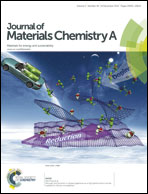Free-standing high-voltage LiCoO2/multi-wall carbon nanotube paper electrodes with extremely high areal mass loading for lithium ion batteries
Abstract
Lightweight, high-capacity and high-power LiCoO2 (LCO)/multi-wall carbon nanotube (MWCNT) free-standing electrodes are fabricated by a simple paper-making process. These electrodes have the highest LCO loading of 40 mg cm−2 reported in the literature, comparable to state-of-the-art battery mass loading. LCO/MWCNT paper electrodes have high flexibility, uniform material mass loading, low surface resistivity, and an outstanding rate capability of 142 mA h g−1 at 4C at 4.3 V. When coated with 2 cycle Al2O3 by ALD, LCO/MWCNTs attain high capacities of 179 mA h g−1 and 206 mA h g−1 at 4.5 V and 4.6 V, respectively. At 4.5 V, ALD coated LCO/MWCNTs preserves 95% of their initial capacity of 170 mA h g−1 at 1C after 85 cycles. A full cell with a LCO/MWCNT cathode shows a capacity retention of 77% after 500 deep cycles. By reducing the weight of electrodes and increasing the working voltage simultaneously, the LCO/MWCNT electrode structure can significantly improve the energy/power density of lithium ion batteries without changing the electrode material system, and therefore, has great potential to be used with ultrathin, ultralight consumer electronic devices as well as electric vehicles.


 Please wait while we load your content...
Please wait while we load your content...